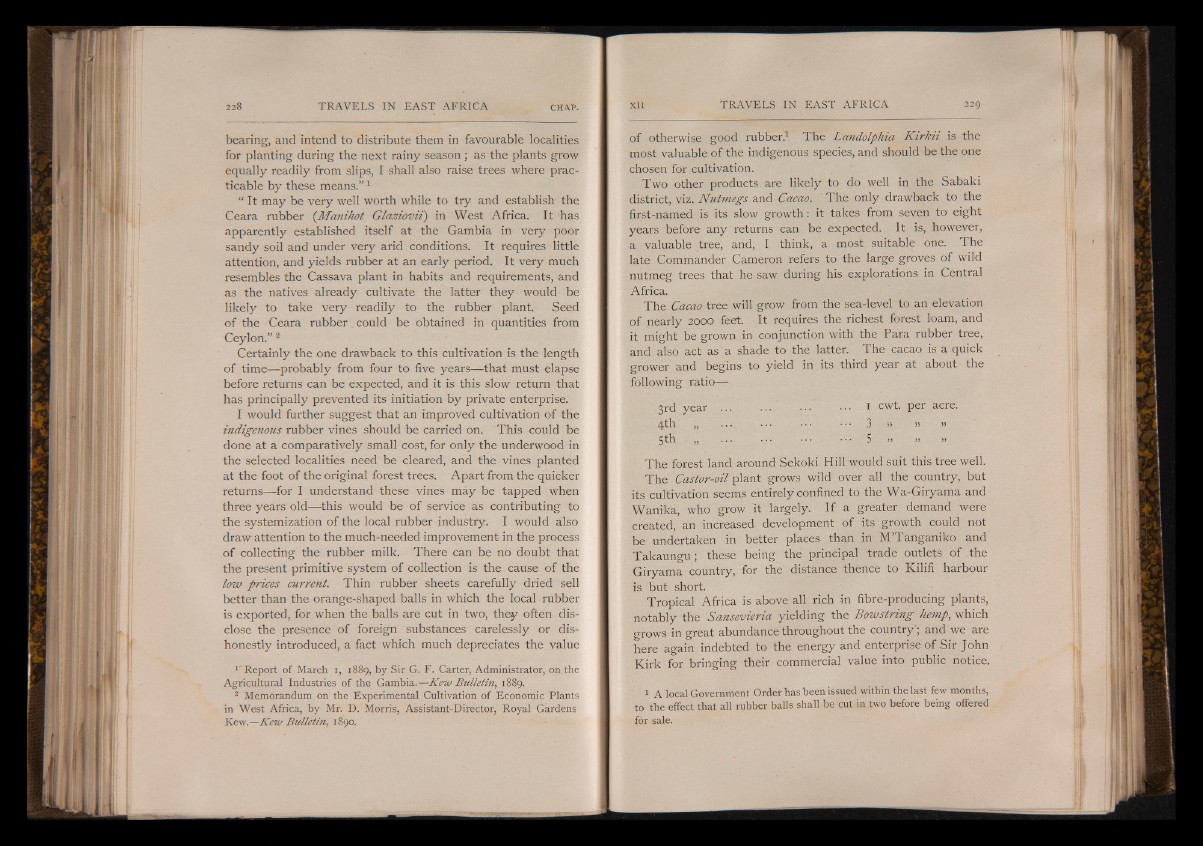
bearing, and intend to distribute them in favourable localities
for planting during the next rainy season ; as the plants grow
equally readily from slips, I shall also raise trees where practicable
by these means.” 1
“ It may be very well worth while to try and establish the
Ceara rubber (.Manihot Glaziovii) in West Africa. It has
apparently established itself at the Gambia in very poor
sandy soil and under very arid conditions. It requires little
attention, and yields rubber at an early period. It very much
resembles the Cassava plant in habits and requirements, and
as the natives already cultivate the latter they would be
likely to take very readily to the rubber plant. Seed
of the Ceara rubber could be obtained in quantities from
Ceylon.” 2
Certainly the one drawback to this cultivation is the length
of time— probably from four to five years— that must elapse
before returns can be expected, and it is this slow return that
has principally prevented its initiation by private enterprise.
1 would further suggest that an improved cultivation of the
indigenous rubber vines should be carried on. This could be
done at a comparatively small cost, for only the underwood in
the selected localities need be cleared, and the vines planted
at the foot of the original forest trees. Apart from the quicker
returns— for I understand these vines may be tapped when
three years old— this would be of service as contributing to
the systemization of the local rubber industry. I would also
draw attention to the much-needed improvement in the process
of collecting the rubber milk. There can be no doubt that
the present primitive system of collection is the cause of the
low prices current. Thin rubber sheets carefully dried sell
better than the orange-shaped balls in which the local rubber
is exported, for when the balls are cut in two, they often disclose
the presence of foreign substances carelessly or dishonestly
introduced, a fact which much depreciates the value
r Report of March I, 1889, by Sir G. F. Carter, Administrator, on the
Agricultural Industries of the Gambia.—Kew Bulletin, 1889.
2 Memorandum on the Experimental Cultivation of Economic Plants
in West Africa, by Mr. D. Morris, Assistant-Director, Royal Gardens
Kew.—Kew Bulletin, 1890.
of otherwise good rubber.1 The Landolphia K irk ii is the
most valuable of the indigenous species, and should be the one
chosen for cultivation.
Two other products, are likely to do well in the Sabaki
district, viz. Nutmegs and Cacao. The only drawback to the
first-named is its slow growth: it takes from seven to eight
years before any returns can be expected. It is, however,
a valuable tree, and, I think, a most suitable one. The
late Commander Cameron refers to the large groves of wild
nutmeg trees that he saw during his explorations in Central
Africa.
The Cacao tree will grow from the sea-level to an elevation
of nearly 2000 feet. It requires the richest forest loam, and
it might be grown in conjunction with the Para rubber tree,
and also act as a shade to the latter. The. cacao is a quick
grower and begins to yield in its -third year at about the
following ratio—
3rd year ... ... ••• ••• 1 cwt. per acre.
4th ,, ... ••• ••• • • - 3 » >> »
5th ,, ... ... ••• ••• 5 » » »
The forest land around Sekoki Hill would suit this tree well.
The Castor-oil plant grows wild over all the country, but
its cultivation seems entirely confined to the Wa-Giryama and
Wanika, who grow it' largely. If a greater demand were
created, an increased development of its growth could not
be undertaken in better places than in M’Tanganiko and
Takaungu; these being the principal trade outlets of the
Giryama country, for the distance thence to Kilifi harbour
is but short.
Tropical Africa is above all rich in fibre-producing plants,
notably the Sansevieria yielding the Bowstring hemp, which
grows in great abundance throughout the country'; and we are
here again indebted to the energy and enterprise of Sir John
Kirk for bringing their commercial value into public notice.
1 A local Government Order has been issued within the last few months,
to the effect that all rubber balls shall be cut in two before being offered
for sale.